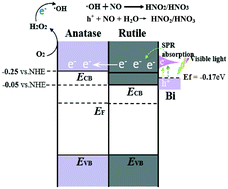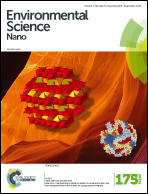Noble metal-free Bi nanoparticles supported on TiO2 with plasmon-enhanced visible light photocatalytic air purification†
Abstract
Semimetal bismuth (Bi) is an emerging non-noble metal-based plasmonic metal, which has demonstrated exceptional behavior as a unique plasmonic photocatalyst/cocatalyst. In the present work, Bi nanoparticles were uniformly deposited on the well-known TiO2 particles (Degussa, P25) with mixed phases of anatase and rutile by a facile eco-friendly synthesis at room temperature. The Bi-deposited TiO2 nanocomposites demonstrated highly enhanced photocatalytic performance for removal of ppb-level NO in air under visible-light irradiation (λ > 420 nm). The improved photocatalytic capability was found to be crucially dependent on the catalyst architecture: Bi nanoparticles with a diameter (dBi) of 5–8 nm deposited on the surface of TiO2 particles acted as active sites for visible-light-driven electron and hole separation. The enhanced charge separation was well supported by photoluminescence, photocurrent generation and Bode-phase spectra. Significantly, the exceptionally high visible-light photocatalytic capability of the optimized Bi–Ti-50 sample (the mass ratio of Bi to TiO2 is 50%) was also superior to that of universally known non-metal-doped TiO2. The photocatalysis was enhanced through SPR-mediated activation of the Bi particles by visible light followed by consecutive electron transfer in Bi/rutile/anatase interfaces, as supported by the action spectra. The electrons produced from the plasmonic activation of Bi particles could transfer to the conduction band of rutile and then to adjacent anatase TiO2 because of the high potential difference between Bi and rutile TiO2. Also, the free electrons could transfer from Bi to the conduction band of anatase and then to rutile TiO2 owing to the high mass ratio of anatase phase in P25 resulting in the direct contact of the Bi nanoparticles and anatase TiO2. A new photocatalysis mechanism of Bi-deposited TiO2 nanocomposites was proposed on the basis of active species trapping. The catalyst architecture elucidated here for promoted plasmonic photocatalysis would be beneficial for the design and development of more effective visible-light-driven photocatalysts for environmental remediation and could open a new avenue for utilization of low-cost Bi nanoparticles as a substitute for noble metals to promote the utilization efficiency of solar energy.


 Please wait while we load your content...
Please wait while we load your content...